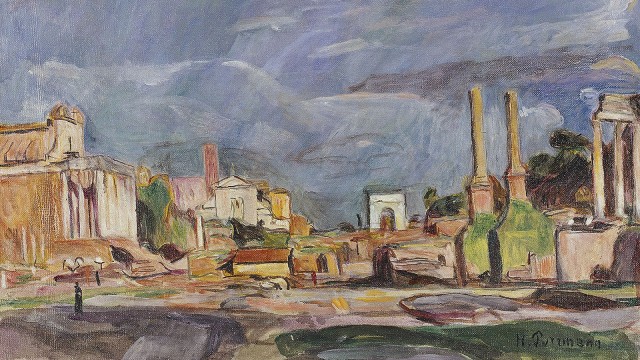
Works in the Collection
Hans Purrmann’s entire oeuvre reflects an artistic use of color that is characterized by an individual attitude to the meaning and practice of painting rather than adhering strictly to the styles of classical modernism. His resultant special status means that he cannot be pigeonholed with the programmatic artist groups of his early period, and this has always partly defined the reception of his work, too. Initially, Purrmann had a brief affiliation with impressionism after his time as a student of Franz von Stuck at the academy in Munich. This earned him recognition by Max Liebermann and Max Slevogt and led him to join the "Berliner Sezession". However, from 1905/1906, after his move to Paris, he gravitated mainly towards the artists now regarded as the pioneers of modernism: Paul Cézanne and Henri Matisse. In a short series of retrospective articles published in the Swiss magazine "Das Werk" from 1946 onwards, Purrmann himself explained his early, firm rejection of what would otherwise have proved to be a successful path in German art after the turn of the century. Starting with “Erinnerungen an meine Studienzeit” (Recollections of My Student Days), the series contains his views on his former teacher Franz von Stuck as well as the salon painting of the late 19th century of which von Stuck was one proponent. Purrmann saw this as a style of art and painting typified by imitation, pretense, pomposity, and false patina that was nonetheless only possible with a precise knowledge of the old master techniques. By contrast, added Purrmann, the biggest impressions from his time in Munich stemmed from the exhibitions at the Glaspalast in Munich and his encounters there with the art of the Swiss painter Ferdinand Hodler, the artifacts at the Kunsthandlung Littauer, including Japanese woodcuts and reproductions of Velasquez and Degas, as well the works of Lovis Corinth and Hans von Marées. Purrmann’s fondness for simple yet determined lines, formal balance, detachment of color from the subject matter and the ensuing rejection of the principle of local color, and the artistically skillful execution of particularly down-to-earth subjects manifested itself already here. Stung by Franz von Stuck’s criticism that “his paintings were full of effect but lacking in spirit”, Purrmann ultimately turned his back on Munich and first headed for Berlin, partly at the instigation of his first art dealer Paul Cassirer, before settling in Paris a few months later.
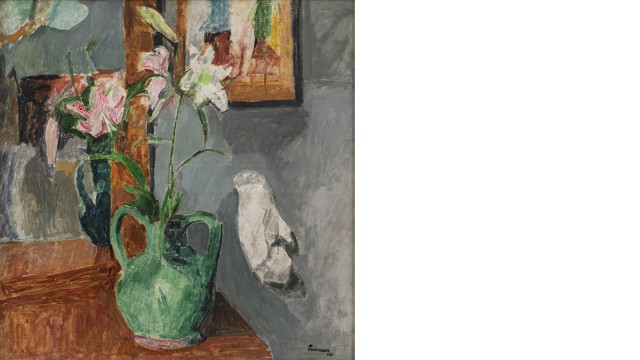
Hans Purrmann’s work "Blumen mit Gipshand” is an early product of his engagement with the French avant-garde, which he had steadily embraced since after his first stay in Paris in 1903. The painting marks an attempt to move away from spatial illusionism and towards a spatial effect that is broken down into color fields and contrasts. This is underscored by the free positioning of a roughly outlined body of white color representing the hand on a gray background. It is suggestive to think that this painting embodies Purrmann’s own interpretation of the “Cubism” style introduced by Pablo Picasso and Georges Braques, with the cubist view of the world essentially eschewing all previous fundamental rules and norms of painting. However, it was his his acquaintance and lifelong friendship with Henri Matisse that shaped Hans Purrmann’s time in Paris. With Matisse’s work he felt an enduring connection. Therefore, as well as setting himself the task of totally doing away with the academic model, Purrmann experienced the artistic rivalry between Matisse and Picasso, which came to a head in the question of how much the freedom of painting would allow for the deformation of its subject matter. In siding with his teacher and friend Matisse, Purrmann himself followed Matisse's notion of a harmonic system, and stayed true to it, even after his time in Paris, in the classical genres of landscape, nude, still life, and interior painting.
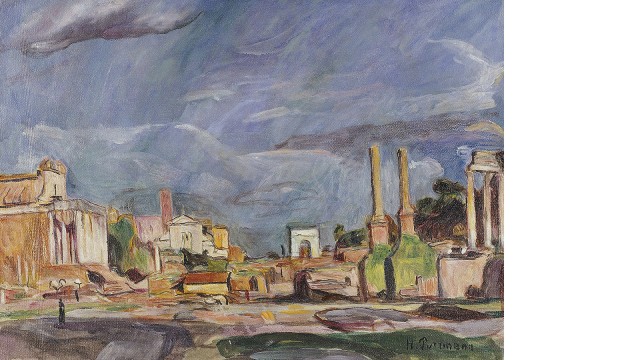
After the First World War, Hans Purrmann lived mainly in Rome with his family between 1922 and 1927, and went on lengthy trips to the Gulf of Naples, Ischia, and Sorrento. In this phase, Purrmann was increasingly influenced by the modulation of color originating from Cézanne, which Purrmann counted among the terms in French art theory most relevant to him, along with “rapport", "peinture", and "ensemble". "Forum Romanum" (1925) and "Früchtestilleben" from 1930 show different aspects in the painter's eventually established system of painting. Both paintings are typified by the representation of the subject matter through atmospheric color impressions. In "Forum Romanum”, they are specifically apparent from the juxtaposition of finely balanced color cadences in the vividly luminous structuring of the architectural backdrop. By contrast, Purrmann expresses the artistic understanding of an "ensemble” and its compositional principles with contrast-rich colorism in his later work “Früchtestilleben".
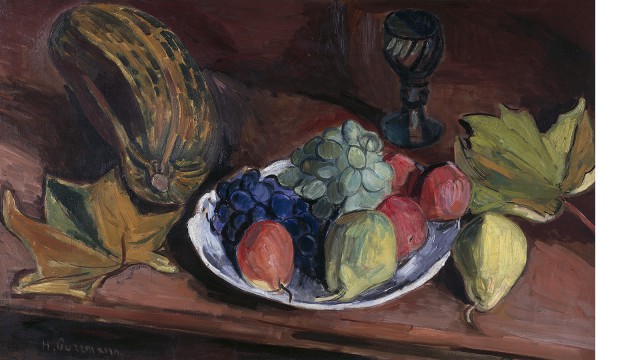
From 1932, Purrmann, by this time back in Berlin, was the subject of increasingly personal slurs. They were first aimed at his commissioned work for the district council building in his home town of Speyer, which was covered with a swastika flag as the Nazis seized power. In 1933, works by Purrmann were displayed in defamatory exhibitions in Karlsruhe and Nuremberg. At the same time, the Purrmann family’s financial situation gradually deteriorated. The struggle for a way to live legally in another European country again ultimately led to Purrmann’s successful application to run the Villa Romana in Florence in 1935, initially on a three-year contract. Despite significant pressure from the Nazis, Purrmann managed to stay in Florence until 1943. His refuge in Florence enabled the artist to keep on pursuing his coloristic work free from political interference. And although Purrmann had no job security beyond 1938, his paintings from this period, as evidenced by the 1941 painting "Villa Romana Florenz", were unaffected by his difficult and increasingly grim circumstances.
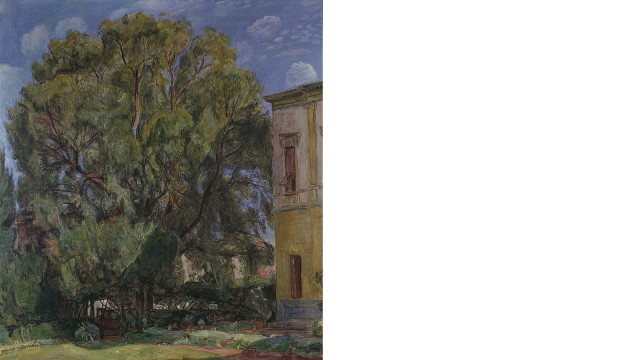
On escaping to Switzerland in 1943, Purrmann ended up in Montagnola in Ticino. From there, after the end of the Second World War, he went on his travels again, which also took him back to Ischia. Even in the final phase of his creative career, the most important aspect of a picture for Purrmann was to treat the intrinsic value of the color in its vibrant beauty as a coloristic experience. Here, the work on atmosphere and effect, as shown by a dry "peinture" in the landscape pictures from Rome and Florence, shifts to a dense, intensely colored setting of ornamentally connected shapes. One example of this type of landscape painting is "Weg mit Olivenbäumen bei Lacco Ameno" from 1956. The art historian Werner Haftmann also mentions “the dignity of décor and valuation of color” in his memories of the artist, which also prompted him and Arnold Bode to include Hans Purrmann in their selection of artists represented in "documenta 1” in 1955.
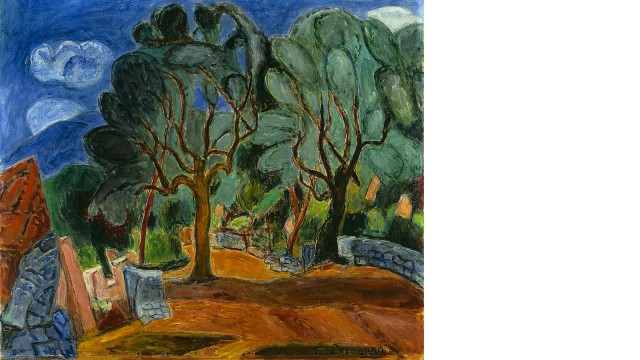
Biography
Hans Purrmann (1880–1966): Born in Speyer, trains and works as a decorative painter at his father's firm in Speyer. 1895–1897 Studies at the Kunstgewerbeschule Karlsruhe. From 1897, studies art at the Akademie der Bildenden Künste München, first drawing under Gabriel von Hackl, then painting under Franz von Stuck. The “Henry-Hilgard-Stipendium zur Förderung der bildenden Künstler in der Pfalz” allows Purrmann to continue his studies; he has works shown in the exhibitions of the "Münchner Secession". 1904–1905 Resident in Berlin. 1905 Purrmann moves to Paris and joins the cosmopolitan group of artists, critics, and collectors at the "Café du Dôme". Becomes acquainted with the artists Henri Matisse and André Derain, the founders of “Fauvism”. From 1907: Studies the oeuvre of Paul Cézanne. 1908 First trip with Henri Matisse to Germany; "Académie Matisse” established in Paris; Purrmann becomes the head of the studio. 1911 Features in an exhibition at Paul Cassirer’s gallery in Berlin. 1912 Features in the Sonderbund exhibition in Cologne. When the First World War breaks out in 1914, the workshop and his apartment in Paris are partially destroyed, along with the remaining works and works of his art collection. 1914–1916 Resident in Beilstein, then moves to Berlin. 1918 First major solo exhibition at Paul Cassirer’s gallery. 1919, at the suggestion of Max Slevogt and Max Liebermann, joins the “Preußische Akademie der Künste", and then the acquisition committee of the Nationalgalerie Berlin. 1920 First trip to Rome, where the Purrmann family has its main residence from 1923 to 1927. From 1925, a growing number of solo exhibitions at galleries in Basel, Kaiserlautern, and Nuremberg. 1931 Commissioned work for the district council building in Speyer, 1932 Completion of the triptych "Allegorie der Kunst und Wissenschaft", which attracts heavy criticism as soon as it is installed. 1935 Purrmann moves to Florence and takes charge of the "Deutsche Künstlerstiftung Villa Romana". 1937 Purrmann is labeled as “degenerate”, and works from public collections are seized. Until 1943, Purrmann is resident mainly in Florence despite the challenging political situation, then escapes to Switzerland in October. In 1944, relocates from Zurich to Montagnola in Ticino. 1948 Gains a work permit in Switzerland. This is followed by extensive solo exhibitions and inclusion in exhibitions at Swiss and German museums. 1950 Publication of the first monograph on his life and work. 1955 Included in "documenta 1" in Kassel. Three major retrospectives are held during his lifetime in 1960, 1962, and 1963, including at the Kunstverein in Hanover and the Haus der Kunst in Munich, which also showcase Purrmann’s graphic work.
